Tough guy biker adventure Full Throttle still kicks ass
Revisiting a LucasArts classic.
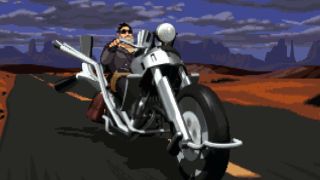
Full Throttle isn't so much a point-and-click adventure as a point-and-kick adventure. While many adventure game protagonists are bumbling, unlikely heroes who make up for their physical shortcomings by relying on their wits to solve problems, square-jawed biker Ben is more comfortable using his fists and feet.
More than one puzzle in the game is solved by kicking something, and this refreshingly no-nonsense approach is what sets Full Throttle apart from other classic LucasArts adventures. I mean, why solve a series of increasingly absurd puzzles to unlock a door when you can just boot it off its hinges?
Released in 1995, Full Throttle was written and designed by Tim Schafer, whose name has become synonymous with LucasArts adventure games, from Monkey Island to Grim Fandango. Schafer was influenced by Mad Max and Kurosawa films; particularly the idea of a stoic, tough guy hero who's never looking for trouble, but finds it anyway.
Visually, lead artist Peter Chan took inspiration from Mike Mignola's Hellboy comics, which is evident in his use of heavy shadows and silhouettes.
LucasArts greenlit Full Throttle on Schafer's assurance that it would be a commercial hit, and he was right. Their adventure games usually sold about 100,000 copies, but a million people bought Full Throttle.
Schafer was influenced by Mad Max and Kurosawa films
Ben is on the run for a murder he didn’t commit, which is bad, but not as bad as the fact that Corley Motors—the last motorcycle manufacturer in the country—is ceasing production of its legendary bikes to mass produce minivans.
And so our stubbly, leather-clad anti-hero embarks on a quest to clear his name and, more importantly, save his way of life from being destroyed by soulless corporate suits.
The biggest gaming news, reviews and hardware deals
Keep up to date with the most important stories and the best deals, as picked by the PC Gamer team.
Full Throttle is a game about freedom and authenticity, leaning into the romantic idea of an outlaW biker on the road, rather than the grim reality you might have read about in Hunter S. Thompson's Hell's Angels. It's bikers as pirates, as wandering samurai, not shady criminals.
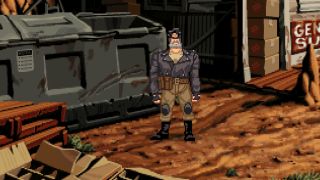
The Mad Max influence also extends to the setting. This is not a post-apocalyptic world, but it has the feel of one, with miles of barren desert highway, gangs hijacking trucks, and mohawked bikers picking fights with each other just for the fun of it.
Full Throttle's desolate slice of the American West is a bleak, lawless, forgotten place, which makes it perfect for a nihilistic biker like Ben. The game also features some futuristic elements, including hover-cars, which adds a unique flavour to its aesthetic—but without it drifting into sci-fi territory. Artistically, this is one of LucasArts' most interesting games, and it remains a real treat to look at, even on a big, modern monitor.
But it wouldn't be anything without its cast. Tim Schafer is known for writing memorable characters, and Full Throttle is full of them. Ben is a great hero because he's a gravel-voiced hardass, but he also has a heart. The late Roy Conrad plays him perfectly, delivering his lines with a knowing, bone-dry humour.
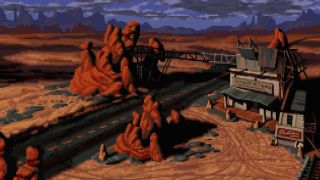
The supporting cast is great too, including villainous corporate stooge Ripburger, melancholy mechanic Mo, and treacherous trucker Emmet. This was one of the first videogames to cast mostly professional actors registered with the Screen Actors Guild, which is reflected in the quality of its voice acting.
And you can't reminisce about Full Throttle without mentioning the music. The soundtrack is a huge part of its personality and enduring legacy, whether it's the atmospheric original score by longtime Tim Schafer collaborator Peter McConnell, or the fuzzy dive bar rock supplied by biker band The Gone Jackals.
The use of their song Legacy in the opening titles is still one of the best uses of licensed music in a videogame, perfectly setting the tone for the adventure to come. Ben roaring along the highway to that guitar riff is as good as it gets.
The soundtrack is a huge part of Full Throttle's personality and enduring legacy
Compared to previous LucasArts adventures, Full Throttle is more streamlined and cinematic. Much of its 3-5 hour running time is made up of beautifully animated cutscenes, and the 'verb buffet' interface popularised by Monkey Island is replaced with a flaming skull that offers only a handful of ways to interact with the world—including Ben's favourites, the gloved fist and the leather boot.
The idea behind this, according to Schafer, was that constantly looking up and down to interact with stuff was distracting. The new interface also gave the artists more space to play with, with evocative backgrounds that cover the entire screen, rather than being obscured by the UI.
Full Throttle is also lighter on puzzles than most LucasArts adventures—and the puzzles it has are relatively straightforward, at least compared to the likes of Day of the Tentacle.
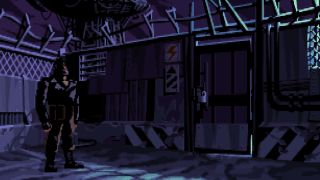
What it's good at is making its puzzles feel like a natural fit for a game about badass bikers, hiding them in plain sight. A few hours into the game, Ben finds himself on a notorious desert back-road where riders from rival gangs meet up to fight.
You have to figure out which weapons work against which bikers, clicking the mouse to furiously swing your chainsaw, plank of wood, or whatever you happen to be wielding. It has the feel of an action minigame, but it's really just an elaborately presented puzzle.
A side effect of this streamlined design is that Full Throttle is pretty short, taking anything between 3-5 hours to finish. Over the years this has been cited by many as its biggest weakness, but I actually think it's a perfect length. Compared to the languid pace of most point-and-click adventures, this is a breakneck sprint through a series of thrilling set-pieces, with only short moments of downtime between them.
And, really, that's what a game about this kind of character should be like. If Ben spent more time wandering around solving puzzles than tearing around on his hog, he wouldn't be much of a biker, would he?
There are a few ways to play Full Throttle. You can play the original DOS version, or use an emulator like DOSBox. But for the best experience, Double Fine's 2017 remaster is worth seeking out.
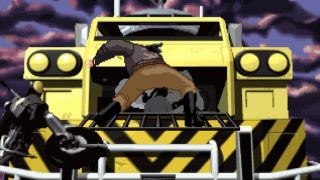
You can play this with the original visuals, which I recommend, because as much effort clearly went into the remastered graphics, the original pixel art just looks better.
But the best thing about this version is the uncompressed audio, taken from the original DAT recordings. As a fan who's played this game maybe fifty times over the years, it's a strange sensation hearing that classic dialogue—and that killer soundtrack—without a layer of compression fuzz. The remaster also comes with a load of concept art and a fun, insightful commentary track led by Schafer.
Full Throttle endures because of its story, characters, and setting, not its puzzles. It's rarely held up as an example of great point-and-click adventure design, but in every other respect it's one of the finest—and most original—games LucasArts ever released. It also cemented Tim Schafer as someone with a knack for creating worlds that people love existing in, and characters they love hanging out with.
LucasArts once threatened to release a third-person 3D sequel called Hell on Wheels, without the involvement of Schafer, but it was cancelled—and I'm glad. Full Throttle is a one-off, and its legacy should be left unspoiled.
If it’s set in space, Andy will probably write about it. He loves sci-fi, adventure games, taking screenshots, Twin Peaks, weird sims, Alien: Isolation, and anything with a good story.
Most Popular


